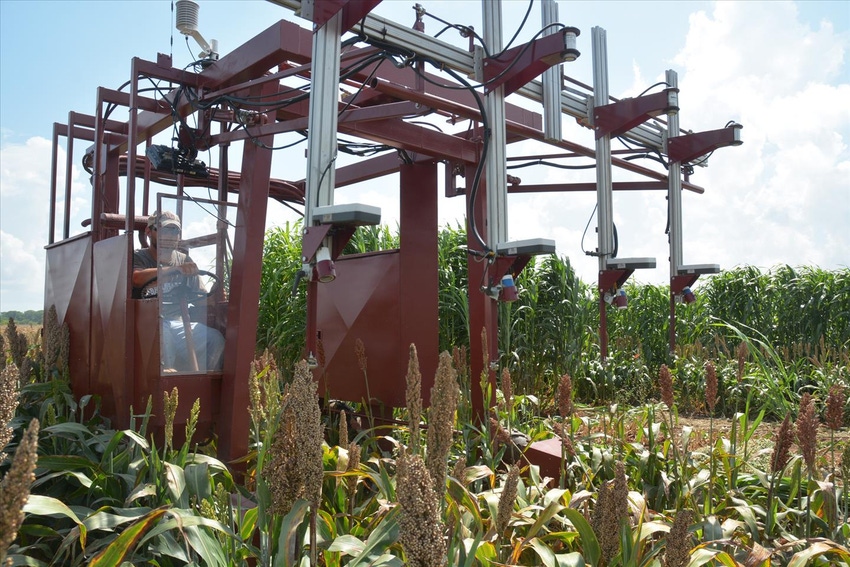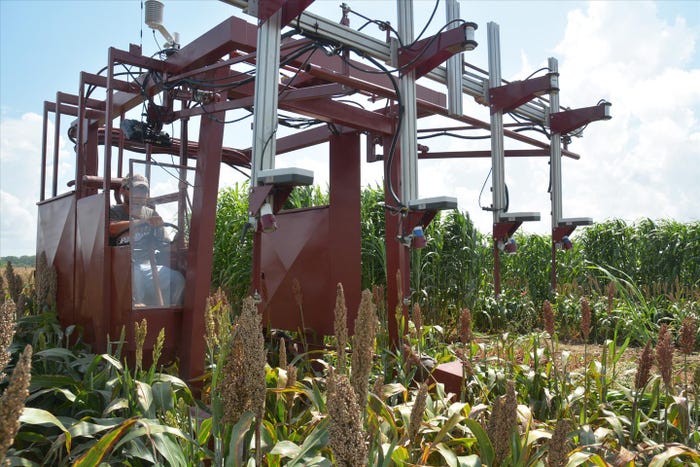Phenotyping helps research without labor, machine harvesting
Further development of high-throughput field phenotyping tools needed.

It has been said that a picture is worth a thousand words, but for Dr. Seth Murray of Texas A&M University, the images captured by an unmanned aerial vehicle (UAV) or self-propelled ground vehicle could be worth more than a thousand man-hours. The images can lead to the selection of the next higher-yielding crop variety not in 10 years but in just two or three years.
Murray, a Texas A&M AgriLife corn breeder in the soil and crop science department at College Station, Texas, said the study of genomics and DNA markers has been around for 30 years, but only recently have they been routinely incorporated into the breeding programs.

Undergraduate student Colby Ratcliff drives ground vehicle to capture information about each sorghum plot. Source: Texas A
Genomics allows researchers to identify genetic locations in plants exhibiting certain phenotypic traits they need to improve production.
What is needed now is more development of high-throughput field phenotyping (HTFP) tools for the next generation of plant breeding, Murray said.
Working with large teams of faculty, staff and students from across the Texas A&M system, he said his current project is to develop analysis methods and software that will allow HTFP data collection to aid in his breeding decisions.
“One of the big traits we are after is plant height in corn,” he said. “We spend three weeks with a crew of 10 people taking notes in the field, and one whole week of that is devoted to plant height.”
Murray explained that plant height in Texas corn is highly correlated to grain yield. Under the stressful growing conditions of most Texas fields, taller corn seems to have more vigor to resist those stresses. He acknowledged that just selecting for tall plants would not improve yield, but it is one of many traits he uses.
To get the data that will help a breeder know which varieties are providing the necessary traits, measurements must be taken, Murray explained. Plant height is a primary and relatively straightforward example of a phenotype that could be automated by HTFP data collection.
The most promising tools to improve field-relevant phenotyping are systems that include sensors carried by ground vehicles or UAV, he said. Sensing data provide two major opportunities: to automate routine measurements in the field and to discover new phenotypes that were previously infeasible or impossible to collect.
Those personnel walking the fields must measure with sticks, but now there are sensors that can do that, Murray said. Presently, he is working with other researchers to test three different techniques: a fixed-wing aircraft, a rotary copter aircraft and a ground vehicle.
He noted, “The first question now is: Can we use these images to replace the measurements we are already taking for height?”
Murray said one of the current problems is that the UAV tools are targeted at hobbyists and growers and don’t necessarily work for the small plot work he needs as a plant breeder. That is why it's vital to have the research and interaction of Texas A&M colleagues from aerospace engineering, mechanical engineering, ecosystem science and management, agricultural engineering and geography in College Station as well as collaborating teams in Corpus Christi and Uvalde, Texas.
“We have learned that even the commercial tools for growers are not yet ready for prime time without some intellectual expertise,” he said.
According to Murray, the researchers have about 17,000 plots out in the field of 5,000 different genetic sources that need to be measured. As such, he said there is no way height measurements could be taken throughout the growing season with the old methods. However, he said the exciting part is that using UAVs has allowed them to take measurements every week throughout the growing season.
“As we begin to mine this data, we can determine if some of these varieties grow well under early-season stress and some under late-season stress. If we can identify those and cross them, then we think we can get varieties that grow well under all seasons of stress. It’s a lot of data, though, and we are just beginning to have analytical tools for these discoveries,” Murray noted.
Two of Murray’s graduate students are working to confirm genes that relate to plant height. “Individual genes have small effects, and it is hard for us to accurately measure those changes," he said. "With this, we could measure that and see, ‘Do these genes actually work?’”
Murray’s research project includes a first-of-its-kind high-clearance, self-propelled ground vehicle built to include all of the sensors he needs. It has ultrasonic sensors that use sound waves to measure height.
Murray said they needed an upgradable sensor payload to measure multiple variables of plant growth and development across the many different breeding programs at Texas A&M. The vehicle has a 10 ft. clearance with high stability in order to phenotype corn, sorghum and other row crops through maturity without disrupting the crop.
Additionally, the ground vehicle has active sensors for measuring normalized difference vegetation index (NDVI), infrared thermometers to measure the ground and crop temperatures and a weather station to measure air temperature and wind speed. All of that information is fed into a data logger, combined with a real-time kinematic global positioning system signal, to precisely tell where that machine is and what it is measuring.
“We had our machine custom made because corn grows so tall,” he said. “We are in the process of writing the analysis code. By the end of this year, we will know whether it can do what we need it to do.�”
Murray said they’ve also had the fixed-wing plane fly all the fields involved in one experiment with corn and sorghum, taking measurements once a week.
“Now, we have lots of data to go back and look at. The sky’s the limit. There are many things beyond height, but height is the simplest,” he said.
Murray noted that temperature and NDVI are things agronomist have been using for a while. Another is texture.
“Combines for small plot work are often less accurate than we would like, but they are faster than hand harvesting and hand shelling," he said. However, "if the UAVs or ground vehicle can give us an indication of the potential in early generations, then we could plant experiments without the goal of harvest, just getting the UAV data to get a value of the variety.”
Murray said it’s like looking for one needle in the haystack. Finding technology that can do that faster would allow plots with value to be harvested, he explained, adding that instead of growing 17,000 plots, maybe 70,000 plots could be grown.
About the Author(s)
You May Also Like



